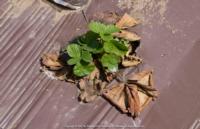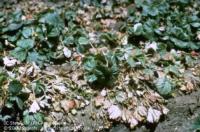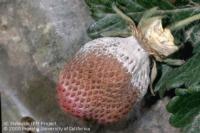Strawberries, problems
-
There several diseases that affect strawberries. Common diseases and control measures are listed below. Read more about strawberry diseases.
Verticillium wilt
Caused by a soilborne fungus.
Symptoms - older leaves wilt, turn brown and dry up while young leaves stay green. Eventually plant dies.
Solutions - Avoid land that has previously been planted in susceptible crops such as tomatoes, potatoes, cucumbers, peppers. Plant resistant cultivars, such as Hecker.
Root rot
Caused by several fungi, but mainly by Phytophthora spp. Symptoms - the fungus attacks crowns and roots, particularly in poorly drained or overirrigated plantings, causing stunted growth and wilted leaves. Crown tissue is discolored brown. Plants eventually die.
Solutions - more of a problem when soil stays wet. Prevent root rot by planting on raised beds in well-drained soil. Avoid overwatering. There is no control for affected plants.
Botrytis fruit rot
Caused by a fungus, a very serious rot of strawberry fruit also known as gray mold. The fruit develops lesions which turn light brown and spread over the fruit.
Solutions - most serious during cool, wet weather. Use plastic mulch that separates the fruit from direct contact with the ground and plant in raised beds. Spcae plants to allow for good air circulation. Fungicides are essentially ineffective.
Strawberries are relatively pest free. Common pests and control measures are listed below. Read more about strawberry pests.
Weevils
Several weevils attack strawberries above and below the ground. Most insecticides are ineffective against them. Abandoning the planting and moving to a pest-free area is recommended.Spider mites
Spider mites produce webbing and stippling of the foliage, which stunts strawberry plants, reducing yields and fruit quality. Dusty conditions contribute to spider mite populations. Overhead watering, especially when combined with an insecticidal soap, is effective in controlling most mites because it washes them off the plants and destroys their habitat.Aphids
Aphids can stunt plants and cause damage to foliage and fruit during the early, cool part of the season. Generally, insecticidal soap applied at weekly intervals provides adequate control.Leafrolling caterpillars
The salt marsh caterpillar and cutworm feed on strawberry plants. They can be controlled effectively with Bacillus thuringiensis (Bt) and registered insecticides.Slugs and snails
Feed on foliage and fruit and can be controlled with repeated applications of metaldehyde, iron phosphate, or by hand-picking.



